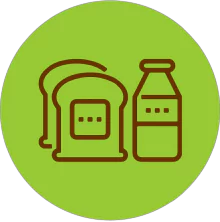


Food intolerance means Body struggles with digestion or irritates digestive system.
Food intolerance occurs when the body lacks the enzymes necessary for digestion.

Eating problem foods can cause digestive issues like bloating, constipation, headaches, or other problems.
 Bloating
Bloating
 fatigue
fatigue
 constipation
constipation
 Skin Problem
Skin Problem
 weight Issue
weight Issue
 Headache
Headache


An allergy is the reaction of the body's immune system to normally harmless substances such as pollen, various foods, house dust mites, etc. In normal people, contact with these substances (allergens) does not trigger a reaction.
In an In an allergy sufferer, however, the immune system recognises these substances as a threat and produces a misdirected protective reaction. The immune system can overreact by producing antibodies that attack the allergen. This can lead to wheezing, itching, a runny nose, watery or itchy eyes and other food allergy symptoms.

To date, there is no permanent cure for allergies. The best possible solution is to recognize the allergenic food and avoid it as much as possible. The symptoms are annoying and can lead to lifestyle problems, but are not life-threatening. 45% of the population are affected. Symptoms are delayed and can last up to 72 hours, shellfish, soy and corn
 ITCHING
ITCHING
 TROUBLE BREATHING
TROUBLE BREATHING
 HIVES OR RASH
HIVES OR RASH
 HEADACHE
HEADACHE
 SNEEZING
SNEEZING
 RUNNY NOSE
RUNNY NOSE





Symptoms are troublesome and may cause lifestyle issue but not life threatning

45% of the Population Is Affected

Symptoms are delayed and can take up to 72 hours to appear

Common food intolerances are gluten (found in bread) and milk

Symptoms can be very severe and may lead the body to have fatal anaphylactic response

2% of the Population Is Affected

Symptoms useally appear immediatally within 2 hours of exposure

Common food allergies are peanuts, shellfish , soy and corn
Choose the most appropriate food allergy test for you. Have a blood sample taken in a laboratory or at home.
A digital copy of your food allergy test results will be sent to you by secure email.
Your nutritionist will offer you personalized nutritional advice based on your test results and needs.
You are unique. Thank you to the food allergy testing options and nutritional advice, you can now also nourish your body uniquely.


Get to the bottom of it with our experts. Understand not only the triggers, but also how to manage food intolerance, gluten intolerance, lactose intolerance, indigestion, constipation, bloating, acidity, stomach problems and check for food intolerance.
GET CONSULT
Living with a food allergy can have a negative impact on the quality of life of patients and their families, as they must remain vigilant for accidental exposures. Allergic reactions to food can range from mild gastrointestinal symptoms or skin rashes to severe reactions that can be fatal for children and adults with sign of food allergies. ............

Food intolerances are estimated to affect up to 20% of the population, but a full understanding of diagnosis and treatment is complicated because the presentation and associated non-immunological mechanisms are highly variable. This review aims to provide an up-to-date scientific overview of common food intolerances leading to gastrointestinal and/or extraintestinal symptoms..........
Read More →
Irritable bowel syndrome (IBS) is a chronic functional gastrointestinal disorder characterized by abdominal pain or discomfort and changes in bowel habits. The pathophysiology of the disease is still unknown, but several factors are thought to play a role, including visceral hypersensitivity, intestinal dysmotility... They offer a sample collection service which is very useful. The reports are quick and very helpful. .........
Read More →
The report is sent by WhatsApp, E-mail as well as the hard copy by post.
It takes 5 days to receive the test results.
No fasting is required for this test.
Take the guesswork out of your health and nutrition
Doctor prescription not required to take the test
We’ve been supporting people with intolerances and allergies for 10 years, so we understand just how important accuracy is. Over this time we’ve developed food intolerance and food allergy tests that are processed with stringent testing and quality control processes in place. Samples for each food intolerance test are collected using a unique wand system, which helps to keep it protected during transit. Our allergy test uses a secured container. We also label each one so it can be tracked. Once it arrives at our in-house laboratory, our team of highly trained and qualified technician will run the relevant tests, using fully maintained and calibrated equipment and IT systems. we want to empower people with the information they need to make informed choices about what they eat, and how their body reacts. We’re proud that we have a reproducibility rate of over 98%. This means that when we test the same person’s sample on two different occasions, greater than 98% of the results will be the same.
An effective way to manage the symptoms of any suspected food intolerance such as gas or bloating is to follow an elimination diet. This is where you remove certain foods from your diet before adding them again, in order to identify what might be causing an adverse reaction in your body. This is very difficult to do without getting a test first as you don’t know what foods to start eliminating. If you suspect you might have a food intolerance, unknowingly reintroducing those foods into your diet again could trigger uncomfortable symptoms. An elimination diet helps you identify trigger foods but it can be hard to stick to. However, when used with the results of a food intolerance test, you already have a clear idea of what could be causing an intolerance to flare up. Using our traffic light system, where red indicates high reactivity and green normal reactivity, you’ll be able to see which food to cut out and include first. Without a test, understanding the specific foods and proteins that cause a reaction can be difficult. For example, if you often have an upset stomach and you eat bread, you could be intolerant to gluten or yeast or wheat. Knowing exactly what triggers your body means you don’t have to cut out certain foods and nutrients unnecessarily. When you get your results, our nutritionists can help you to create eating plans and offer advice on alternative options to replace trigger foods
Food intolerance and food allergy are two different types of adverse reactions to food that can cause discomfort, but they have different causes and require different approaches to diagnosis and management. Food intolerance testing and food allergy testing are two methods used to diagnose these conditions. In this post, we will explore the difference between the two. Food Intolerance Testing Food intolerance occurs when the body has difficulty digesting certain foods or food components. This can cause a range of symptoms, including bloating, abdominal pain, diarrhea, and skin rashes. Unlike food allergies, food intolerances do not involve the immune system and are not life-threatening. Food intolerance testing is a method used to identify specific foods that may be causing these symptoms. There are several different types of food intolerance tests, including blood tests, skin prick tests, and elimination diets. Blood tests measure the levels of certain antibodies in the blood that are produced in response to specific foods. Skin prick tests involve exposing the skin to small amounts of allergens to see if a reaction occurs. Elimination diets involve removing certain foods from the diet and gradually reintroducing them to see if symptoms improve. Food Allergy Testing Food allergies are a more serious type of adverse reaction to food. They occur when the immune system overreacts to a specific food protein, triggering a range of symptoms that can be life-threatening in some cases. Symptoms of food allergies can include hives, swelling of the face or throat, difficulty breathing, and anaphylaxis. Food allergy testing is a method used to identify specific foods that may be causing an allergic reaction. The most common method of food allergy testing is a skin prick test, which involves exposing the skin to small amounts of allergens to see if a reaction occurs. Blood tests may also be used to measure the levels of specific antibodies in the blood that are produced in response to specific foods. In summary, food intolerance and food allergy are two different types of adverse reactions to food. Food intolerance is caused by difficulty digesting certain foods or food components, while food allergy is an immune system response to specific food proteins. Food intolerance testing and food allergy testing are two different methods used to diagnose these conditions. If you suspect that you have a food intolerance or food allergy, it is important to seek advice from a healthcare professional. They can help you determine which type of testing is appropriate for your situation and provide guidance on how to manage your symptoms.